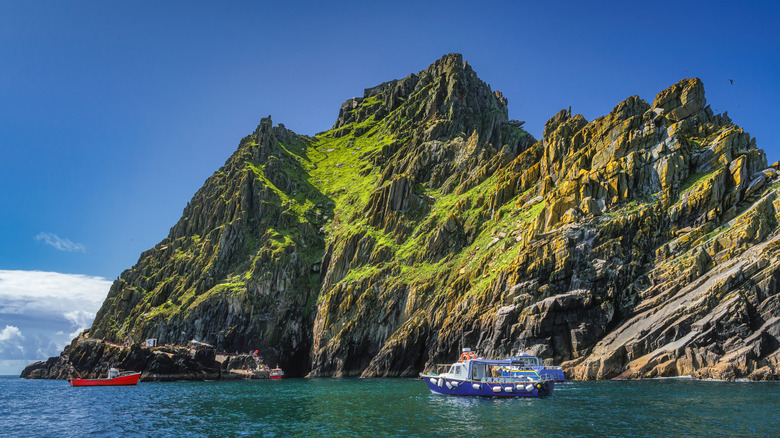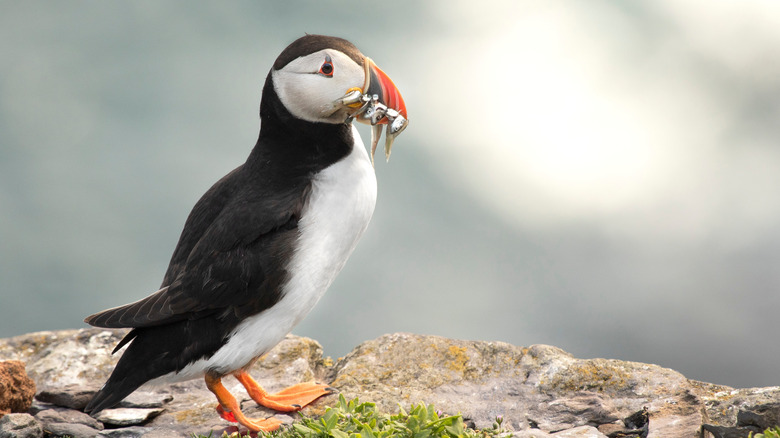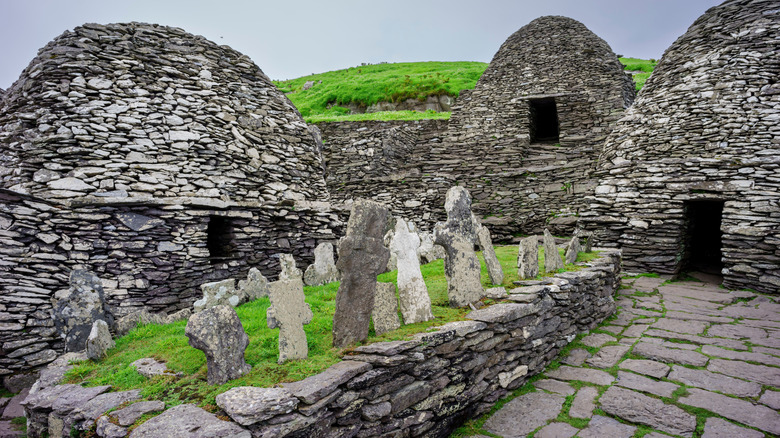The European UNESCO Treasure And Star Wars Filming Site Seeing More Tourists Than It Can Handle
If you're heading west by boat from County Kerry, Ireland, you'll see dramatic rocky cliffs ahead, protruding 715 feet above the turbulent Atlantic waters. As you near this imposing pinnacle, you'll notice signs of life: lush vegetation dots the sandstone formations, seabirds nest along steep rock faces, and seals suntan on the shores. This is Skellig Michael, a pyramid-shaped island eight miles off the mainland. Its original name, Sceilg Mhichíl, is derived from the Irish word for "crag," and it's dedicated to St. Michael the Archangel. It was recognized as a UNESCO World Heritage site in 1996 — just one of four on the island of Ireland and one of two in the Republic of Ireland as of this writing.
Between the 6th and 8th centuries, a Christian hermitage was founded here by Gaelic monks who believed that one should live in harsh remoteness to attain intimacy with God. Indeed, there was no more isolated place than Ireland, which was then thought to be the end of the earth. The monks built six clocháns (stone beehive-shaped living spaces), terraced gardens for food production, and two oratories, and they existed in challenging solitude before abandoning the settlement in the 13th century. From the 1500s onwards, Skellig Michael became a site for religious pilgrimage and a testament to early Christian resilience.
But even if you've never stepped foot in Ireland, you may have already seen this European treasure — It was one of the filming locations for "Star Wars Episode VII: The Force Awakens" and "Star Wars Episode VIII: The Last Jedi," serving as Luke Skywalker's desolate sanctuary on the planet Ahch-To. Unfortunately, due to its silver-screen fame, it has become one of the most "overtouristed" places in Europe. Although UNESCO recommended capping visitors at 11,000 annually, 2018 saw 16,792 people frequenting the fragile site, with higher numbers in other years — and this could have dire consequences for its future.
How unsustainable tourism has impacted Skellig Michael
Skellig Michael's settlement was built in the medieval style, using dry-stone masonry. And while the still-intact structures were suitable for the monastic population (estimated to be no larger than twelve monks and one abbot at any given time), their architects couldn't have foreseen foot traffic from thousands of annual visitors, traipsing across and wearing down these ancient ruins, many centuries later. This traffic poses several risks to the remains, including damage to the dry-stone walls and terraces, breakage of important features like the crosses, and more.
Of course, there are more than just medieval rocks to protect: The island is a nesting and breeding ground for many species of seabirds, including Atlantic puffins, razorbills, storm petrels, and kittiwakes. Its neighboring twin island, Little Skellig, is home to the world's second-largest colony of gannets (over 27,000 pairs). Nesting and breeding can be disrupted by large groups, harmful products might be left unintentionally by visitors, and the avian residents' habits and survival instincts may change over time through becoming increasingly accustomed to the presence of people. Other human effects, like climate change and commercial overfishing, have also negatively impacted the seabirds' habitat and food sources.
Beyond the repercussions for the monastic ruins and seabird population, heavy tourism has also changed the atmosphere of this profoundly spiritual place. Instead of the quiet footsteps of monks ascending the 618 stairs to the monastery, you'll hear the sounds of hiking boots stomping the ground, expensive cameras clicking, and the chatter of excited tourists. While it was once a bastion of peaceful solitude created by the deeply religious, Skellig Michael's Christian asceticism — and Jedi mysticism — may continue to be lost if the island's ancient settlement, natural ecosystems, and biodiversity are not protected.
Preserving Skellig Michael for future generations
In recent years, there have been a number of measures taken to address the over-tourism. Only 15 boat operators are given landing rights, and there's a daily limit of 180 visitors. During the tourist season, the Office of Public Works has staff on the island to better manage tourists and oversee its conservation initiatives. Not everyone approves of the imposed visitor caps and limited operating licenses — in particular, the boat operators, guesthouse owners, and others in the tourist industry who are affected economically. However, in order to meet the standards of the UNESCO-approved management plan established by the Irish government, these measures are necessary. And nobody wants Skellig Michael to become yet another beautiful destination in the world sadly ruined by overtourism.
If you'd like to find out whether the Force is with you by visiting the site of the first Jedi temple, ensure that you book well in advance, as demand typically exceeds availability. Note that Skellig Michael is only accessible between early May and late September — outside of that period, waters are temperamental and conditions are dangerous. Full-day landing tours depart between 8 and 10:30 a.m. from Derrynane Harbour, Valentia, Portmagee, or Ballinskelligs and last four to five hours. Tours range from $140 to $170, while cruises that don't land are half that price. When visiting, remember to stick to the designated pathways, follow your guide's instructions carefully, and bring out everything you take in so that this sacred island can be preserved for future generations.
If you're not able to snag a coveted spot on one of the boats during your trip, don't worry — there are plenty of other breathtaking sights to see in this region, including the Ring of Kerry, one of the best places to visit in Ireland.


